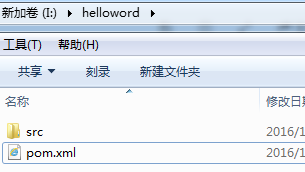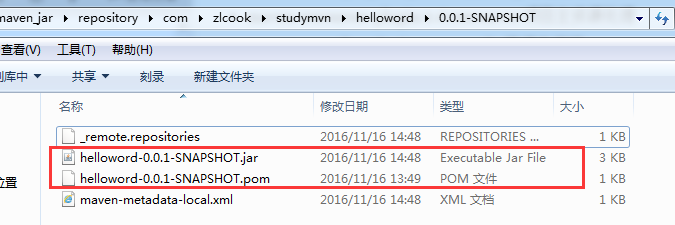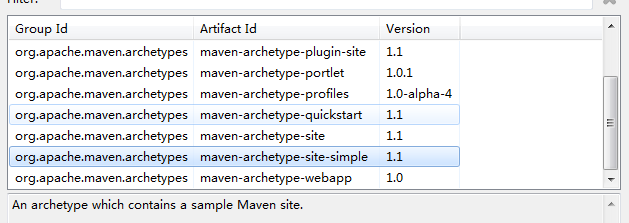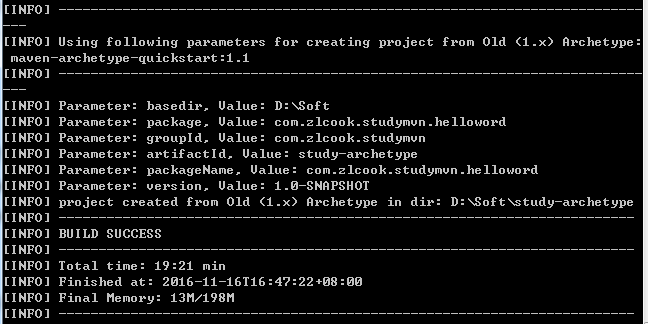1.编写POM
Maven项目的核心文件是pom.xml,POM(Project Objcet Model)项目对象模型,该文件中定义了项目基本信息包括如何构建、项目依赖、打包类型、项目继承等等。
为helloword项目编写一个pom.xml文件
在I:/目录下新建一个helloword文件夹,在文件夹中建一个pom.xml文件,内容如下:
<?xml version="1.0" encoding="UTF-8"?>
<project xmlns="http://maven.apache.org/POM/4.0.0"
xmlns:xsi="http://www.w3.org/2001/XMLSchema-instance"
xsi:schemaLocation="http://maven.apache.org/POM/4.0.0
http://maven.apache.org/maven-v4_0_0.xsd">
<modelVersion>4.0.0</modelVersion>
<groupId>com.zlcook.studymvn</groupId>
<artifactId>helloword</artifactId>
<version>0.0.1-SNAPSHOT</version>
<packaging>jar</packaging>
<name>maven helloword project</name>
</project>解释
- modelVersion指定了当前Pom模型的版本,对于maven2、maven3写4.0.0
- groupId 、artifactId、version三个元素定义了一个项目或者构件(artifact )坐标,在maven中任何jar、pom、war都是以基于这些基本的坐标进行区分的。
- groupId定义了项目属于哪个组,这个组一般和项目所在公司存在联系。如baidu建立了一个名为weixin的项目,那么groupId=com.baidu.weixin。
- artifactId定义了当前maven项目在组中的唯一ID,我们为这个hello world项目定义artifactId为helloword.
- packaging 指定了项目的打包类型,默认是jar,打包类型有jar、war、pom
- version指定了helloword项目当前版本,SNAPSHOT为快照版,说明项目处于开发期。
版本号解释
x.x.x-里程碑--->
第一个x表示项目版本有大变动如架构变化1.0->2.0,第二个x表示项目分支变化,第三个x表示项目分支的变化次数。
里程碑:SNAPSHOT开发版本,alpha项目组内部测试版本,beta公开使用测试版本,Release(RC)稳定版,GA可靠版本 - name项目名称,方便用户可以看的懂。
2.编写主代码
- 项目主代码和测试代码不同,项目主代码会被打包到最终的构件中(如jar),而测试代码值在运行测试时用到,不会打包。
- 那么主代码要写在哪里才会被maven识别呢?默认maven假设项目主代码位于src/main/java目录下,所以我们遵循约定在该目录下创建文件com/zlcook/studymvn/helloword/HelloWord.java
内容如下:
package com.zlcook.studymvn.helloword;
public class HelloWord
{
public String say(){
return "hello maven";
}
public static void main(String[] args){
System.out.print(new HelloWord().say());
}
}一个简单的java类
** java代码注意
- 在绝大多数情况下,应该把项目主代码放到src/main/java目录下(遵循maven约定),无须额外配置,maven会自动搜寻该目录找到项目主代码
- java类的包名com.zlcook.studymvn.helloword,这与之前在POM中定义的groupId和artifactId相吻合。建议都这么写,这样更加清晰符合逻辑,也方便搜索构建或java类。

2.1编译主代码
打开命令行,进入到项目根目录下运行mvn clean compile得到如下结果
I:\helloword>mvn clean compile
[INFO] Scanning for projects...
[INFO]
[INFO] ------------------------------------------------------------------------
[INFO] Building maven helloword project 0.0.1-SNAPSHOT
[INFO] ------------------------------------------------------------------------
[INFO]
[INFO] --- maven-clean-plugin:2.5:clean (default-clean) @ helloword ---
[INFO]
[INFO] --- maven-resources-plugin:2.6:resources (default-resources) @ helloword
---
[WARNING] Using platform encoding (GBK actually) to copy filtered resources, i.e
. build is platform dependent!
[INFO] skip non existing resourceDirectory I:\helloword\src\main\resources
[INFO]
[INFO] --- maven-compiler-plugin:3.1:compile (default-compile) @ helloword ---
[INFO] Changes detected - recompiling the module!
[WARNING] File encoding has not been set, using platform encoding GBK, i.e. buil
d is platform dependent!
[INFO] Compiling 1 source file to I:\helloword\target\classes
[INFO] ------------------------------------------------------------------------
[INFO] BUILD SUCCESS
[INFO] ------------------------------------------------------------------------
[INFO] Total time: 2.383 s
[INFO] Finished at: 2016-11-15T16:30:35+08:00
[INFO] Final Memory: 14M/220M编译完后文件夹

解释mvn clean compile命令
- clean告诉maven清理输出目录 target/
- compile告诉maven编译项目主代码。
依次执行的目标任务有
- maven-clean-plugin:2.5:clean 删除target文件夹,默认maven构建的所有输出都在target/目录中
- maven-resources-plugin:2.6:resources 项目主资源处理,未定义项目资源,会跳过,skip non existing resourceDirectory;
- maven-compiler-plugin:3.1:compile 编译主代码,将项目主代码编译到target/classes目录。
- maven-clean-plugin:2.5:clean 、maven-resources-plugin:2.6:resources、maven-compiler-plugin:3.1:compile对应了一些Maven插件及插件目标,maven-clean-plugin:2.5:clean是maven-clean-plugin插件的clean目标。
3.编写测试代码
- 为了是项目结构清晰,maven的测试代码默认目录是src/test/java。所以在helloword文件夹下创建该目录。
3.1添加测试依赖
- 编写的测试代码需要依赖JUnit,所以修改pom.xml如下:
<?xml version="1.0" encoding="UTF-8"?> <project xmlns="http://maven.apache.org/POM/4.0.0" xmlns:xsi="http://www.w3.org/2001/XMLSchema-instance" xsi:schemaLocation="http://maven.apache.org/POM/4.0.0 http://maven.apache.org/maven-v4_0_0.xsd"> <modelVersion>4.0.0</modelVersion> <groupId>com.zlcook.studymvn</groupId> <artifactId>helloword</artifactId> <version>0.0.1-SNAPSHOT</version> <packaging>jar</packaging> <name>maven helloword project</name> <dependencies> <dependency> <groupId>junit</groupId> <artifactId>junit</artifactId> <version>4.10</version> <scope>test</scope> </dependency> </dependencies> </project> - dependencies元素下可以包含多个dependency元素以声明项目的依赖,每个依赖都是由groudId,artifactId,version组成了构件的唯一性。有了这段配置信息maven就会自动下载junit-4.7.jar。那么maven会去哪里下载呢?答:maven会自动访问中央仓库(repol.maven.org/maven2/)下载需…
- dependency元素中还有scope配置,scope为依赖范围。scope的取值如下:
1.test范围指的是测试范围有效,在编译和打包时都不会使用这个依赖,换句话说在测试代码中导入import JUnit代码没问题,但是在主代码中使用import JUnit代码会造成编译错误,同时在主代码中导入了测试代码中的类,在编译时也会出错,比如“符号找不到”。因为在编译主代码时测试代码包括scope为test的依赖都不会使用。 如:junit
2.compile范围指的是编译范围有效,在编译和打包时都会将依赖存储进去。(默认方式)
3.provided依赖,在编译和测试过程有效,最后生成war包时不会加入,诸如:servlet-api,因为servlet-api,tomcat等服务器已经存在了,如果再打包会冲突
4.runtime在运行时依赖,在编译的时候不会依赖,测试运行时才依赖,如mysql-connector-java
注:在项目之间只有complie范围的依赖才会传递
3.2编写测试代码及测试
在src/test/java目录下写测试代码文件
src\test\java\com\zlcook\studymvn\helloword\HelloWordTest.java
package com.zlcook.studymvn.helloword;
import static org.junit.Assert.assertEquals;
import org.junit.Test;
public class HelloWordTest
{
@Test
public void testSay(){
HelloWord helloWord = new HelloWord();
String result = helloWord.say();
assertEquals("hello maven",result);
}
}使用JUnit4,需要执行测试的方法都需要加上@Test注解。
测试案例写完,执行maven测试命令,在helloword文件下执行命令:mvn clean test
得到结果如下:
I:\helloword>mvn clean test
[INFO] Scanning for projects...
[INFO]
[INFO] ------------------------------------------------------------------------
[INFO] Building maven helloword project 0.0.1-SNAPSHOT
[INFO] ------------------------------------------------------------------------
[INFO]
[INFO] --- maven-clean-plugin:2.5:clean (default-clean) @ helloword ---
[INFO] Deleting I:\helloword\target
[INFO]
[INFO] --- maven-resources-plugin:2.6:resources (default-resources) @ helloword
---
[WARNING] Using platform encoding (GBK actually) to copy filtered resources, i.e
. build is platform dependent!
[INFO] skip non existing resourceDirectory I:\helloword\src\main\resources
[INFO]
[INFO] --- maven-compiler-plugin:3.1:compile (default-compile) @ helloword ---
[INFO] Changes detected - recompiling the module!
[WARNING] File encoding has not been set, using platform encoding GBK, i.e. buil
d is platform dependent!
[INFO] Compiling 1 source file to I:\helloword\target\classes
[INFO]
[INFO] --- maven-resources-plugin:2.6:testResources (default-testResources) @ he
lloword ---
[WARNING] Using platform encoding (GBK actually) to copy filtered resources, i.e
. build is platform dependent!
[INFO] skip non existing resourceDirectory I:\helloword\src\test\resources
[INFO]
[INFO] --- maven-compiler-plugin:3.1:testCompile (default-testCompile) @ hellowo
rd ---
[INFO] Changes detected - recompiling the module!
[WARNING] File encoding has not been set, using platform encoding GBK, i.e. buil
d is platform dependent!
[INFO] Compiling 1 source file to I:\helloword\target\test-classes
[INFO]
[INFO] --- maven-surefire-plugin:2.12.4:test (default-test) @ helloword ---
[INFO] Surefire report directory: I:\helloword\target\surefire-reports
-------------------------------------------------------
T E S T S
-------------------------------------------------------
Running com.zlcook.studymvn.helloword.HelloWordTest
Tests run: 1, Failures: 0, Errors: 0, Skipped: 0, Time elapsed: 0.035 sec
Results :
Tests run: 1, Failures: 0, Errors: 0, Skipped: 0
[INFO] ------------------------------------------------------------------------
[INFO] BUILD SUCCESS
[INFO] ------------------------------------------------------------------------
[INFO] Total time: 2.699 s
[INFO] Finished at: 2016-11-16T13:49:29+08:00
[INFO] Final Memory: 15M/191M
[INFO] ------------------------------------------------------------------------依次执行的目标有
- maven-clean-plugin:2.5:clean 删除target文件夹
- maven-resources-plugin:2.6:resources 项目主资源处理
- maven-compiler-plugin:3.1:compile 编译主代码
- maven-resources-plugin:2.6:testResources 测试资源处理
- maven-compiler-plugin:3.1:testCompile 编译测试代码,编译通过在target/test-classes下生成了二进制文件
- maven-surefire-plugin:2.12.4:test 运行测试代码,surefire是maven中负责执行测试的插件,并生成测试报告surefire-reports,显示共运行了多少测试,失败了多少,出错了多少,跳过了多少。
由此可见,在执行test之前会先执行compile。
4.打包和运行
4.1打包
项目编译、测试之后,然后就可以打包(package),Hello Word的打包指定了打包类型为jar包。
maven的打包命令:mvn clean package
执行结果:
I:\helloword>mvn clean package
[INFO] Scanning for projects...
[INFO]
[INFO] ------------------------------------------------------------------------
[INFO] Building maven helloword project 0.0.1-SNAPSHOT
[INFO] ------------------------------------------------------------------------
[INFO]
[INFO] --- maven-clean-plugin:2.5:clean (default-clean) @ helloword ---
[INFO] Deleting I:\helloword\target
[INFO]
[INFO] --- maven-resources-plugin:2.6:resources (default-resources) @ helloword
---
[WARNING] Using platform encoding (GBK actually) to copy filtered resources, i.e
. build is platform dependent!
[INFO] skip non existing resourceDirectory I:\helloword\src\main\resources
[INFO]
[INFO] --- maven-compiler-plugin:3.1:compile (default-compile) @ helloword ---
[INFO] Changes detected - recompiling the module!
[WARNING] File encoding has not been set, using platform encoding GBK, i.e. buil
d is platform dependent!
[INFO] Compiling 1 source file to I:\helloword\target\classes
[INFO]
[INFO] --- maven-resources-plugin:2.6:testResources (default-testResources) @ he
lloword ---
[WARNING] Using platform encoding (GBK actually) to copy filtered resources, i.e
. build is platform dependent!
[INFO] skip non existing resourceDirectory I:\helloword\src\test\resources
[INFO]
[INFO] --- maven-compiler-plugin:3.1:testCompile (default-testCompile) @ hellowo
rd ---
[INFO] Changes detected - recompiling the module!
[WARNING] File encoding has not been set, using platform encoding GBK, i.e. buil
d is platform dependent!
[INFO] Compiling 1 source file to I:\helloword\target\test-classes
[INFO]
[INFO] --- maven-surefire-plugin:2.12.4:test (default-test) @ helloword ---
[INFO] Surefire report directory: I:\helloword\target\surefire-reports
-------------------------------------------------------
T E S T S
-------------------------------------------------------
Running com.zlcook.studymvn.helloword.HelloWordTest
Tests run: 1, Failures: 0, Errors: 0, Skipped: 0, Time elapsed: 0.034 sec
Results :
Tests run: 1, Failures: 0, Errors: 0, Skipped: 0
[INFO]
[INFO] --- maven-jar-plugin:2.4:jar (default-jar) @ helloword ---
[INFO] Building jar: I:\helloword\target\helloword-0.0.1-SNAPSHOT.jar
[INFO] ------------------------------------------------------------------------
[INFO] BUILD SUCCESS
[INFO] ------------------------------------------------------------------------
[INFO] Total time: 2.159 s
[INFO] Finished at: 2016-11-16T14:17:36+08:00
[INFO] Final Memory: 16M/187M
[INFO] ------------------------------------------------------------------------依次执行的目标有
- maven-clean-plugin:2.5:clean 删除target文件夹
- maven-resources-plugin:2.6:resources 项目主资源处理
- maven-compiler-plugin:3.1:compile 编译主代码
- maven-resources-plugin:2.6:testResources 测试资源处理
- maven-compiler-plugin:3.1:testCompile 编译测试代码,编译通过在target/test-classes下生成了二进制文件
- maven-surefire-plugin:2.12.4:test
- maven-jar-plugin:2.4:jar 打包插件,将项目主代码打包成一个helloword-0.0.1-SNAPSHOT.jar文件到target/目录下。名称是根据artifact-version.jar规则进行命名的, 如果不想使用该名称,可以在pom.xml文件中使用finalName来定义文件名称,位置
<project> <build> <finalName>项目名称</finalName> </build> </project>
如果不是其它项目可以直接拷贝该jar到项目中使用,如果是maven项目要想直接在pom.xml中引入该jar包,则需要包该jar包安装到本地仓库中。
安装命令:mvn clean install
结果:
...
[INFO] --- maven-install-plugin:2.4:install (default-install) @ helloword ---
[INFO] Installing I:\helloword\target\helloword-0.0.1-SNAPSHOT.jar to D:\Soft\ma
ven\maven_jar\repository\com\zlcook\studymvn\helloword\0.0.1-SNAPSHOT\helloword-
0.0.1-SNAPSHOT.jar
[INFO] Installing I:\helloword\pom.xml to D:\Soft\maven\maven_jar\repository\com
\zlcook\studymvn\helloword\0.0.1-SNAPSHOT\helloword-0.0.1-SNAPSHOT.pom
[INFO] ------------------------------------------------------------------------
[INFO] BUILD SUCCESS
...在执行打包之前,依次执行了编译、测试、打包。
- maven-install-plugin:2.4:install 安装,把jar包安装到本地仓库中,helloword项目在本体仓库文件如图:

4.2运行
- helloword项目中的HelloWord类有一个main方法,默认打包生成的jar是不能直接运行的,因为带有main方法的类信息不会添加到manifest中(解压jar文件后,其中的META-INF/MANIFEST.MF文件没有Main-Class一行)。
MANIFEST.MF文件信息如下:
Manifest-Version: 1.0
Archiver-Version: Plexus Archiver
Built-By: dell
Created-By: Apache Maven 3.3.3
Build-Jdk: 1.8.0_65为了生成可执行的jar文件,需要借助maven-shade-plugin插件,在pom.xml中配置插件如下:
了解更多插件使用
<?xml version="1.0" encoding="UTF-8"?>
<project xmlns="http://maven.apache.org/POM/4.0.0"
xmlns:xsi="http://www.w3.org/2001/XMLSchema-instance"
xsi:schemaLocation="http://maven.apache.org/POM/4.0.0
http://maven.apache.org/maven-v4_0_0.xsd">
<modelVersion>4.0.0</modelVersion>
<groupId>com.zlcook.studymvn</groupId>
<artifactId>helloword</artifactId>
<version>0.0.1-SNAPSHOT</version>
<name>maven helloword project</name>
<dependencies>
<dependency>
<groupId>junit</groupId>
<artifactId>junit</artifactId>
<version>4.10</version>
<scope>test</scope>
</dependency>
</dependencies>
<build>
<plugins>
<plugin>
<groupId>org.apache.maven.plugins</groupId>
<artifactId>maven-shade-plugin</artifactId>
<version>2.4.3</version>
<executions>
<execution>
<phase>package</phase>
<goals>
<goal>shade</goal>
</goals>
<configuration>
<transformers>
<transformer implementation="org.apache.maven.plugins.shade.resource.ManifestResourceTransformer">
<mainClass>com.zlcook.studymvn.helloword.HelloWord</mainClass>
</transformer>
</transformers>
</configuration>
</execution>
</executions>
</plugin>
</plugins>
</build>
</project>- 我们配置了mainClass为com.zlcook.studymvn.helloword.HelloWord,项目打包时会将该信息放到MANIFEST中。
在执行mvn clean install命令
执行完后在target/目录中可以出现两个文件

original-helloword-0.0.1-SNAPSHOT.jar 是原始的jar。
helloword-0.0.1-SNAPSHOT.jar 是带有Main-Class信息的可运行的jar
解压helloword-0.0.1-SNAPSHOT.jar 在META-INF/MANIFEST.MF中包含信息:
Manifest-Version: 1.0
Archiver-Version: Plexus Archiver
Built-By: dell
Created-By: Apache Maven 3.3.3
Build-Jdk: 1.8.0_65
Main-Class: com.zlcook.studymvn.helloword.HelloWord执行jar文件
在控制台输入命令如下,可以看到输出了hello maven结果。

5使用Archetype创建maven项目
5.1需求背景
-
在写helloword项目中我们遵循了maven的约定,比如主代码写在src/main/java,测试代码写在src/test/java下面,pom.xml文件放置项目更目录下等。这些目录结构和pom.xml文件内容称为项目的骨架,当然java项目和javaEE项目的项目骨架是有不同的地方。当我们用maven创建java项目时就必须遵循这些约定,也就是每次都要创建这些目录和pom.xml文件。
-
那么问题来了?每次都自己创建不是挺麻烦的吗?maven不是有好多命令吗可不可以执行某一个命令就可以帮我们自动创建创建好目录结构和pom.xml文件。
答:Maven提供了maven-archetype-plugin插件以帮助我们快速勾勒出项目骨架(当然你也可以自己开发一个)。
5.2案例演示
- 以study-archetype项目为例使用maven archetype在D:\soft盘创建study-archetype项目骨架。
在命令行输入mvn archetype:generate命令。
结果如下:
D:\Soft>mvn archetype:generate
[INFO] Scanning for projects...
[INFO]
[INFO] ------------------------------------------------------------------------
[INFO] Building Maven Stub Project (No POM) 1
[INFO] ------------------------------------------------------------------------
[INFO]
[INFO] >>> maven-archetype-plugin:2.4:generate (default-cli) > generate-sources
@ standalone-pom >>>
[INFO]
[INFO] <<< maven-archetype-plugin:2.4:generate (default-cli) < generate-sources
@ standalone-pom <<<
[INFO]
[INFO] --- maven-archetype-plugin:2.4:generate (default-cli) @ standalone-pom --
-
[INFO] Generating project in Interactive mode
.......
1717: remote -> tr.com.obss.sdlc.archetype:obss-archetype-java (This archetype p
rovides a common skelton for the Java packages.)
1718: remote -> tr.com.obss.sdlc.archetype:obss-archetype-webapp (This archetype
provides a skelton for the Java Web Application packages.)
1719: remote -> uk.ac.ebi.gxa:atlas-archetype (Archetype for generating a custom
Atlas webapp)
1720: remote -> uk.ac.rdg.resc:edal-ncwms-based-webapp (-)
1721: remote -> uk.co.nemstix:basic-javaee7-archetype (A basic Java EE7 Maven ar
chetype)
1722: remote -> uk.co.solong:angular-spring-archetype (So Long archetype for RES
Tful spring services with an AngularJS frontend. Includes debian deployment)
1723: remote -> us.fatehi:schemacrawler-archetype-maven-project (-)
1724: remote -> us.fatehi:schemacrawler-archetype-plugin-command (-)
1725: remote -> us.fatehi:schemacrawler-archetype-plugin-dbconnector (-)
1726: remote -> us.fatehi:schemacrawler-archetype-plugin-lint (-)
Choose a number or apply filter (format: [groupId:]artifactId, case sensitive co
ntains): 888:-
会出现很多可用的archetype供选择。
正如在eclipse中可视化创建maven项目时会出现选择框让你选择合适的archetype。
eclipse中创建maven程序选择合适archetype -
每个archetype前面都会对应一个编号,同时命令行会提示一个默认的编号888,其对应的archetype是maven-archetype-quickstart,该archetype适合用来创建普通java项目的maven结构,如果是javaEE项目可以选择maven-archetype-webapp。
-
直接回车选择888,紧接着会让你选择maven-archetype-quickstart插件的版本,该骨架插件的版本有好几个我们选择编号6。
Choose org.apache.maven.archetypes:maven-archetype-quickstart version: 1: 1.0-alpha-1 2: 1.0-alpha-2 3: 1.0-alpha-3 4: 1.0-alpha-4 5: 1.0 6: 1.1 Choose a number: 6:- 接下来就会提示你输入要创建的项目的groupId、artifactId、version以及包名package
确定项目的信息Define value for property 'groupId': : com.zlcook.studymvn Define value for property 'artifactId': : study-archetype Define value for property 'version': 1.0-SNAPSHOT: : Define value for property 'package': com.zlcook.studymvn: : com.zlcook.studymvn .helloword Confirm properties configuration: groupId: com.zlcook.studymvn artifactId: study-archetype version: 1.0-SNAPSHOT package: com.zlcook.studymvn.helloword Y: : Y
- 接下来就会提示你输入要创建的项目的groupId、artifactId、version以及包名package
- 最后输出创建完成信息

创建完成
查看study-archetype项目

主代码目录src/main/java已经被创建,在该目录下还有一个Java类 com.zlcook.studymvn.helloword.App
测试代码目录也被创建好了,包含一个测试用例 com.zlcook.studymvn.helloword.AppTest。
-
pom.xml文件
里面添加了一个junit依赖,和项目文件编码属性配置<project xmlns="http://maven.apache.org/POM/4.0.0" xmlns:xsi="http://www.w3.org/2001/XMLSchema-instance" xsi:schemaLocation="http://maven.apache.org/POM/4.0.0 http://maven.apache.org/xsd/maven-4.0.0.xsd"> <modelVersion>4.0.0</modelVersion> <groupId>com.zlcook.studymvn</groupId> <artifactId>study-archetype</artifactId> <version>1.0-SNAPSHOT</version> <packaging>jar</packaging> <name>study-archetype</name> <url>http://maven.apache.org</url> <properties> <project.build.sourceEncoding>UTF-8</project.build.sourceEncoding> </properties> <dependencies> <dependency> <groupId>junit</groupId> <artifactId>junit</artifactId> <version>3.8.1</version> <scope>test</scope> </dependency> </dependencies> </project>
Archetype可以迅速构建一个项目骨架,如果很多项目拥有许多自定义的项目结构以及配置文件,比如A公司要求开放的每个maven项目的目录下都要有readme.txt文件等,则完全可以开发自己的Archetype,然后在这些项目中使用自定义的Archetype来快速生成项目骨架。
6.补充:Maven打包的JAR文件目录内容
通过maven打包好的jar包中包含的目录结构分析:
hibernate-ehcache-3.6.10.Final.jar中的文件

- org中时该包中说有源代码被编译后的字节码文件class,这个内容是固定的,不管是使用maven还ant还是gradle构建内容都是一样的。hibernate-ehcache所依赖的包不会被打包进来,他的依赖信息如果是使用maven构建的话会在META-INF中的pom.xml文件中指定。
- META-INF:打包元数据,里面的内容,和构建工具有一定关系。如果你不是使用maven进行打包的话,那么肯定不会有maven这个文件夹。目录内容如下:

MANIFEST.MF文件中内容:
Manifest-Version: 1.0
Archiver-Version: Plexus Archiver
Created-By: Apache Maven
Built-By: gbadner
Build-Jdk: 1.5.0_16
Specification-Title: Hibernate Ehcache Integration
Specification-Version: 3.6.10.Final
Specification-Vendor: Hibernate.org
Implementation-Title: Hibernate Ehcache Integration
Implementation-Version: 3.6.10.Final
Implementation-Vendor-Id: org.hibernate
Implementation-Vendor: Hibernate.org
Implementation-URL: http://hibernate.orgmaven目录中包含两个文件
org.hibernate/hibernate-ehcache/pom.properties
#Generated by Maven
#Wed Feb 08 19:23:01 CST 2012
version=3.6.10.Final
groupId=org.hibernate
artifactId=hibernate-ehcacheorg.hibernate/hibernate-ehcache/pom.xml
<project xmlns="http://maven.apache.org/POM/4.0.0" xmlns:xsi="http://www.w3.org/2001/XMLSchema-instance" xsi:schemaLocation="http://maven.apache.org/POM/4.0.0 http://maven.apache.org/xsd/maven-4.0.0.xsd">
<modelVersion>4.0.0</modelVersion>
<parent>
<groupId>org.hibernate</groupId>
<artifactId>hibernate-parent</artifactId>
<version>3.6.10.Final</version>
<relativePath>../hibernate-parent/pom.xml</relativePath>
</parent>
<groupId>org.hibernate</groupId>
<artifactId>hibernate-ehcache</artifactId>
<packaging>jar</packaging>
<name>Hibernate Ehcache Integration</name>
<description>Integration of Hibernate with Ehcache</description>
<dependencies>
<dependency>
<groupId>${project.groupId}</groupId>
<artifactId>hibernate-core</artifactId>
<version>${project.version}</version>
</dependency>
<dependency>
<groupId>net.sf.ehcache</groupId>
<artifactId>ehcache-core</artifactId>
<version>2.4.3</version>
</dependency>
<dependency>
<groupId>${project.groupId}</groupId>
<artifactId>hibernate-testing</artifactId>
<version>${project.version}</version>
<scope>test</scope>
</dependency>
<dependency>
<groupId>hsqldb</groupId>
<artifactId>hsqldb</artifactId>
<version>1.8.0.2</version>
<scope>test</scope>
</dependency>
<dependency>
<groupId>cglib</groupId>
<artifactId>cglib</artifactId>
<scope>test</scope>
</dependency>
<dependency>
<groupId>javassist</groupId>
<artifactId>javassist</artifactId>
<scope>test</scope>
</dependency>
</dependencies>
</project>